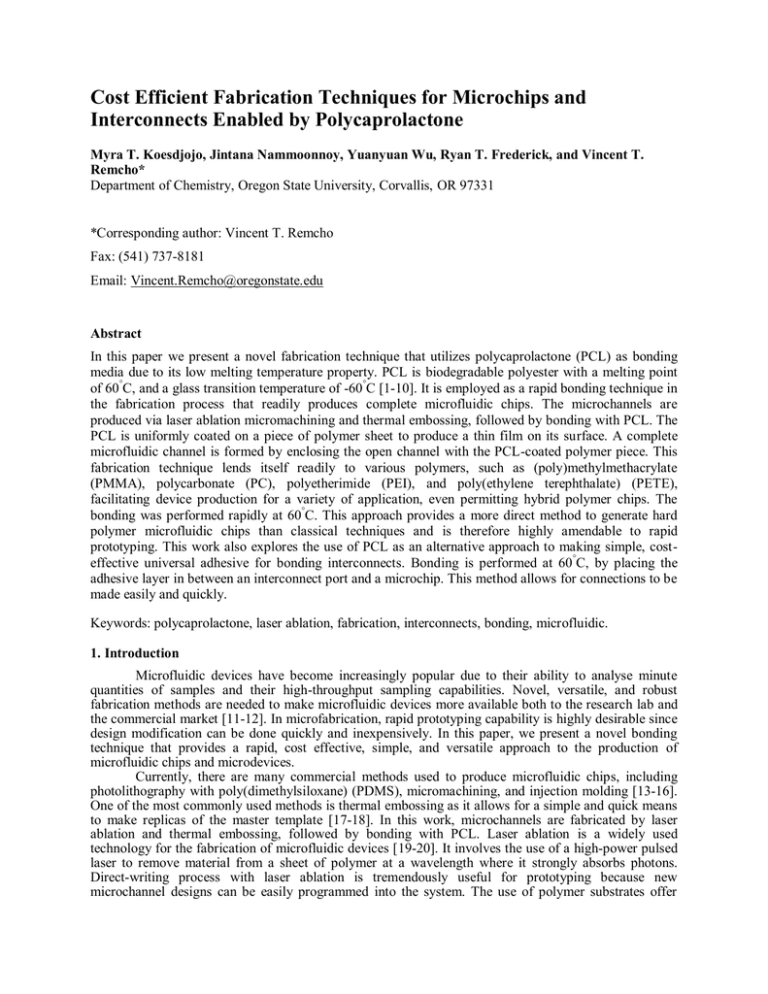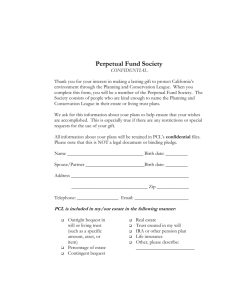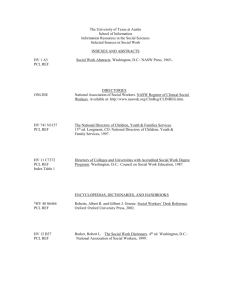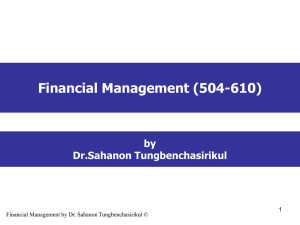Cost Efficient Fabrication Techniques for Microchips and Interconnects Enabled by Polycaprolactone
advertisement

Cost Efficient Fabrication Techniques for Microchips and Interconnects Enabled by Polycaprolactone Myra T. Koesdjojo, Jintana Nammoonnoy, Yuanyuan Wu, Ryan T. Frederick, and Vincent T. Remcho* Department of Chemistry, Oregon State University, Corvallis, OR 97331 *Corresponding author: Vincent T. Remcho Fax: (541) 737-8181 Email: Vincent.Remcho@oregonstate.edu Abstract In this paper we present a novel fabrication technique that utilizes polycaprolactone (PCL) as bonding media due to its low melting temperature property. PCL is biodegradable polyester with a melting point of 60°C, and a glass transition temperature of -60°C [1-10]. It is employed as a rapid bonding technique in the fabrication process that readily produces complete microfluidic chips. The microchannels are produced via laser ablation micromachining and thermal embossing, followed by bonding with PCL. The PCL is uniformly coated on a piece of polymer sheet to produce a thin film on its surface. A complete microfluidic channel is formed by enclosing the open channel with the PCL-coated polymer piece. This fabrication technique lends itself readily to various polymers, such as (poly)methylmethacrylate (PMMA), polycarbonate (PC), polyetherimide (PEI), and poly(ethylene terephthalate) (PETE), facilitating device production for a variety of application, even permitting hybrid polymer chips. The bonding was performed rapidly at 60°C. This approach provides a more direct method to generate hard polymer microfluidic chips than classical techniques and is therefore highly amendable to rapid prototyping. This work also explores the use of PCL as an alternative approach to making simple, costeffective universal adhesive for bonding interconnects. Bonding is performed at 60 °C, by placing the adhesive layer in between an interconnect port and a microchip. This method allows for connections to be made easily and quickly. Keywords: polycaprolactone, laser ablation, fabrication, interconnects, bonding, microfluidic. 1. Introduction Microfluidic devices have become increasingly popular due to their ability to analyse minute quantities of samples and their high-throughput sampling capabilities. Novel, versatile, and robust fabrication methods are needed to make microfluidic devices more available both to the research lab and the commercial market [11-12]. In microfabrication, rapid prototyping capability is highly desirable since design modification can be done quickly and inexpensively. In this paper, we present a novel bonding technique that provides a rapid, cost effective, simple, and versatile approach to the production of microfluidic chips and microdevices. Currently, there are many commercial methods used to produce microfluidic chips, including photolithography with poly(dimethylsiloxane) (PDMS), micromachining, and injection molding [13-16]. One of the most commonly used methods is thermal embossing as it allows for a simple and quick means to make replicas of the master template [17-18]. In this work, microchannels are fabricated by laser ablation and thermal embossing, followed by bonding with PCL. Laser ablation is a widely used technology for the fabrication of microfluidic devices [19-20]. It involves the use of a high-power pulsed laser to remove material from a sheet of polymer at a wavelength where it strongly absorbs photons. Direct-writing process with laser ablation is tremendously useful for prototyping because new microchannel designs can be easily programmed into the system. The use of polymer substrates offer additional advantages with the widely available polymer chemistries that may be tailored to specific chemical and physical needs and the potential for low cost device production. Many bonding procedures have been used, such as solvent bonding [21-23], thermal bonding [2425], microwave bonding [26], laser welding [27], and plasma oxidation [28], in order to provide a quick and effective bonding method allowing for channel preservation. PCL can be used as an alternative bonding material that offers both rapid and simple bonding practice. PCL, a biodegradable polyester with a low melting point of 60oC have been used in drug delivery devices due to their controllable biodegradation rates, polymer scaffolds to assist tissue and cell growth during formation of artificial organs [29-32]. There have been several developments in the area of microfabrication and microfluidic utilizing PCL [33-35]. Recently, Zhao reported the preparation of PCL fluorescence-encoded microspheres through microfluidic approach [35]. In this work, we demonstrate the use of PCL as an excellent alternate bonding material to produce microchannels. The main advantage of this technique is that it provides a more direct method to bond and produce microfluidic chips, microdevices, and its components than conventional techniques Therefore, it is highly amenable to rapid prototyping, and can readily be applied to various polymer materials including PMMA [36-37], PC [38], PEI [39-40], PETE [41], and polyester, facilitating device production for a range of applications. A microfluidic system usually requires multiple interconnects, but currently there are no standard interconnections used in this field [42]. A simple and reliable interconnect is highly desirable for microfluidic devices, especially for rapid prototyping [43]. There are a number of commercial products available to accommodate these needs [44-48]. The most common and simplest approach is the direct integration of tubing to the ports of the microchip using epoxy glue or adhesives. However, direct connection to the inlet reservoir using epoxy often leads to clogging of the microchannels. Commercially available connections, such as NanoPort from IDEX use a threaded nut and ferrule system, and can be integrated onto the chip ports by means of adhesive rings and epoxy glue. The drawback of this method is that the non-removable epoxy glue takes time and requires high temperatures for complete curing, making it incompatible with low glass transition (T g) polymers [48]. Other available products, such as edge connectors provide efficient interfacing and allow rapid connections and reusability. However, they are designed to be interfaced to a standard microchip format, which limits the compatibility of other chips with different geometric layouts or sizes. In this work, a complete microchannel is formed by capping the open channel with a PCL-coated polymer such as PMMA and PC. The bonding is carried out in a thermal press with minimal pressure (less than 100 psi) at 60°C in under a minute. The PCL bonding technique provides a rapid prototyping process in creating microfluidic devices accurately and consistently. PCL is also employed as a rapid technique for bonding interconnects. The PCL layer can simply be placed in between the interconnection ports and reservoirs on a microfluidic chip. Bonding occurs at 60°C when the PCL layer reaches its melting temperature. Once the adhesive layer is activated, it is placed in between the microchip and connection ports for bonding. The process is completed as the temperature cools to below 60 °C. This method allows for connections to be made easily and quickly. Bonding strength of the fabricated chip was tested and measured to withstand pressure exceeding 1500 psi. The microchip fabrication and interface connection methods with PCL have been successfully tested with various polymers and microchannel designs. The ease, low cost, simplicity, and versatility of this technique makes it useful for both rapid prototyping and mass production of polymer-based microfluidic devices. 2. Experimental 2.1. Microfabrication The channels were fabricated with laser ablation and thermal embossing on various polymer substrates. All laser patterning were done with ESI’s model 5330 UV laser µVIA Drill (5 watt, 355 nm) designed for micro-machining (ESI, Portland, OR, 97229). In order to directly pattern the channels, the laser output is focused on the polymer surface. The polymer is held down by vacuum onto a twodimensional stage where it moves relative to a fixed laser beam according to the programmed patterns. We use the direct write method to create channels on various polymer substrates, such as PC, PEI, and PETE (McMaster-Carr, Princeton, NJ, 08543). Thin PCL coat can be produced via spin coating, heat pressing, spraying, or dipping depending on the desired thickness of the final PCL layer. 3% (w/v) PCL solution was made by completely dissolving bulk PCL pellets (Sigma Aldrich, St. Louis, MO, 63103) in organic solvent such as chloroform. A thinner PCL solution can be obtained by mixing in more solvent into the PCL solution. Spin coating provides the most even and consistent results for producing PCL film. To produce PCL films in the 1-3 µm range, about 10 ml of the 3% PCL in chloroform solution was spin coated onto a 6-inch silicon wafer according to the following program: 200 rpm for 10 seconds, 500 rpm for 20 seconds, 2000 rpm for 15 seconds, 0 rpm 10 seconds. The same 3% PCL solution can be used to produce different thicknesses of PCL films by adjusting the spin coat program. The coating procedure was all conducted at room temperature. A complete microchannel is formed by capping the open channel with the PCL-coated polymer. After the individual layers have been assembled, complete bonding is carried out in a thermal press (Fred S. Carver Inc., Summit, NJ) with minimal pressure (100 psi or less) at 60°C. A schematic of the fabrication process is presented in Figure 1. The microfeatures were inspected with an optical microscope, and channel dimensions were measured using a profilometer (Dektak surface profile measuring system, Veeco Instrument Inc., Santa Barbara, CA). The microchip was frozen with liquid nitrogen and fractured to obtain cross-sectional images of the microchip. Morphology of the PCL-bonded microchip was studied using an FEI Quanta (Hillsboro, OR) scanning electron microscope (SEM) operated at 20 kV. 2.2. Interconnect Bonding We utilized polycaprolactone (PCL) as an adhesive layer to bond interconnection ports onto microchip reservoirs. The thin PCL films (50-100 µm) were produced by pressing the PCL pellets in a hot press at 60oC. The PCL film is sandwiched in between a microfluidic chip reservoir and a connection port. Next, bonding is performed at 60°C, and completed as the temperature drops to below 60°C. Fig. 2 shows a schematic of the bonding process of nanoports to a microfluidic chip using PCL film. PEEK NanoPorts were purchased from IDEX (Oak Harbor, WA, 98277). The feasibility of using PCL film as bonding media is also tested on other polymeric materials such as PMMA and PC. Standard PMMA and PC port connectors were machined in-house for a standard ferruled connector to be attached to the microfluidic device. It contained a threaded portion for the fitting and a fluid path with a small port on the bottom for the interface. The port was manufactured using 0.25 inch plastic piece and machined to size using a knee mill. The threaded port was drilled with a #21 drill bit, then tapped with a 10-32 bottoming tap. The fluid paths were drilled using a 1mm drill bit (substitute drill bit size to achieve the desired internal volume). 3. Results and Discussion Currently, production of microfluidic chips is time-consuming and error prone. There are several steps that despite modern techniques and equipment remain difficult. In pursuit of easier and simpler ways to produce chips, a novel fabrication technique using PCL is explored. In this paper, PCL is employed as a bonding material to seal microfluidic channels and to bond their interconnection counterparts. This approach allows us to exploit the PCL’s low melting temperature property as a bonding media where sealing and bonding can be performed easily without the need of any sacrificial layer that is often used to preserve the channel integrity, or complicated bonding process that requires sophisticated instrumentations and equipments [49]. Patterning the microchannels directly on a PCL film allows us to produce microchannels completely out of PCL. However, it also present a challenge as the channel structures would easily collapse during the bonding process. We tested this approach using a 100 µm-thick PCL film. The channel is patterned by directly cutting out the design on the PCL film. Then, the channel is sealed by capping both of its sides with polymer pieces. The three layers were assembled, heated and pressed together until the PCL layer adhered to the polymer pieces. We obtained good seals with excellent bond strength; however, when inspected under a microscope, it was evident that the channel shape and dimension were distorted during the bonding process. The main drawback of this approach is the whole assembly needs to be heated up to the PCL’s melting temperature to facilitate bonding, which in turn causes the PCL channel to soften and leads to channel deformation. To prevent the channel from collapsing during the bonding process, we optimized the method so it would allow us to exploit the PCL’s low melting point as a bonding media, yet provide a way to maintain the channels integrity. In order to prevent channel deformation or clogging, the PCL layer was designed to be made into a very thin film. The thin film can be produced via spin coating, heat pressing, spraying, or dipping. We were able to successfully produce PCL films as thin as 1-3 µm using each process. Next, these PCL films are used to produce larger sheets of polymers that are coated with these PCL films. These PCL-coated polymer sheets can readily be used as capping materials to seal open microchannels. In this work, the microchannels were fabricated by laser ablation and hot embossing. The PCL-coated polymer sheet was positioned facing the open channel, heated and pressed at 60 °C to achieve complete bonding. The sealing process is very quick and can be accomplished in under a minute, while providing consistent performance and great bond strength. During fabrication, the thickness of the PCL coating on the polymer sheet was designed to be as thin as possible. By doing so, the risk of channel clogging and deformation can be minimized. This bonding process will slightly alter the final channel dimension, which is mainly contributed by the thickness of the PCL film (Fig. 3). The thicker the PCL film, the more it will affect the final channel dimension. Therefore, it is pertinent to have an evenly distributed thin film for this bonding method to work successfully. This bonding technique takes advantage of the relatively low melting temperature of PCL; lower than most of the commercially available polymers. Many common polymers used in fabrication, such as PC (Tg~ 150°C) and PMMA (Tg~ 120 °C) have glass transition temperature well above the bonding temperature (60oC). As a result, when bonding occurs, only the PCL layers are melted and subsequently seal the polymer-to-polymer interfaces. The use of PCL as a bonding media is an effective and straightforward method to fabricate polymer-based microfluidic chips, while also providing an inexpensive and simple way to bond interconnects. Our results show that this technique offers high reproducibility, bond strength, and reusability. The success of the bonding technique was evaluated with blue dye to examine leaks resulting from incomplete bonding (Fig. 4). The microscope data collected confirmed that no leaks were observed in the fabricated microchannels. The fabrication process was repeated five times for each microchip with different designs and dimensions to demonstrate the reproducibility of this technique. The working pressure was tested with a high-pressure syringe pump, and shown to withstand pressures exceeding 1500 psi without any signs of leakage or failure. Different channel designs and dimensions were fabricated by laser ablation and embossing. The resulting channels were characterized and measured by profilometry (Fig. 5). The results of the laserablated channel demonstrate that the width profile of the fabricated chip corresponds well to that of the drawn channel dimension programmed on the laser tool. The depth of the channel can be adjusted by controlling the number of repetition the laser beam passes through the channel patterns. A deeper channel may require several laser cutting passes to yield the desired final depth. The laser ablated microchannels were produced on the PEI substrate, while the hot embossed channels were created on PMMA. Fig. 5a shows the profile of the PEI channel with dimension of ~200 µm and 140 µm for the channel width (W) and depth (D), respectively. The profile of one of the embossed PMMA channels with dimensions of ~400 µm (W) and 25 µm (D) is shown in Figure 5b. Both chips were sealed using the same PCL bonding protocol. Sealing open microchannels with PCL coated substrates has allowed us to produce chips rapidly and reproducibly. However, the surface chemistry of these fabricated chips will be non-uniform as PCL is coated on one side of the channel wall. When homogeneous surface chemistry is imperative in the chips application, the PCL coating can be applied on the polymer substrate prior to the laser ablation process. In the laser-cutting step, the PCL layer is removed together with the substrate materials to create the desired microchannels, leaving PCL layers only at the polymers interface for sealing. Another fabrication approach we have tested is to coat both sides of a thin polymer sheet with PCL films to serve as an intermediate bonding layer. The microchips are produced by cutting the channel patterns directly on the PCL-coated polymer with a high-resolution cutting plotter that is capable of producing features in the order of microns with great precision and accuracy. To form a complete microfluidic channel, the cut out PCL-coated channel is enclosed with a top and bottom layers (Fig. 6a). As proof of concept of this bonding approach, we show a three-layered chip fabrication in Fig. 6b that was made with a 75-micron PC (coated with PCL on both sides) as the intermediate layers. The bonding process was evaluated by assessing the dimensions and structures of the fabricated microchips. The cross sections of the microchannels were examined under a microscope as illustrated in Fig. 7. The SEM image shows the cross section of a PMMA microchannel (dimensions: ~300 µm wide 25 µm deep) that was sealed with a PCL-coated PMMA sheet. The results show that we were able to successfully preserve the channels structures using PCL as a bonding media. As can be seen from the image, the channel was successfully obtained without evidence of channel deformation or clogging. The PCL layer has minimal effect on the final channel dimension. This was accomplished by manufacturing the PCL into a very thin layer. We have been able to produce PCL films as thin as 1 µm through various coating procedures. The effect of the PCL layer on the final channel dimension becomes smaller as the channel depth gets larger. For a 100 µm deep channel, a 1 µm PCL film may alter the channel by resulting in a maximum of 0.7% decrease in its final depth. While in a 25 µm channel, it will result in a maximum of 4% decrease in its final depth. The bonding performance of the interconnects to a microchip was characterized by determining its maximum operating pressures. Commercially available NanoPorts from IDEX were used to connect the tubing lines to the microchip reservoirs. Standard PMMA and PC connectors by use of a threaded nut and ferrule system were also fabricated in house to test the PCL bonding performance on various polymer materials. The machined PMMA and PC ports were developed to allow for standard compression tubing connectors, such as those available from IDEX to be interfaced with microfluidic chips. This method allowed for connections to be made easily and quickly in less than a minute as opposed to using epoxy glue that requires a much longer curing time to completely set. The working pressure of these ports was tested with a syringe pump at room temperature, and shown to withstand pressures in excess of 1500 psi without any signs of leakage or failure. Results from this study have demonstrated the use of PCL as an inexpensive and simple way of bonding interconnecting ports onto a microfluidic chip (Fig. 8). With this approach, the process of connecting microfluidic systems to the macro-world can easily be realized. In addition, the technique offers high reproducibility and excellent bond strength. It is simple to use and assemble, low-cost, and reversible, making it possible to reuse the interconnecting ports by simply heating the PCL layer to retrieve the parts. Conclusions A novel approach to fabricate PCL-based microfluidic chips and bonding interconnects was presented. The biodegradable PCL was employed as a bonding material in making entirely disposable plastic chips and interconnections. The method of fabrication provides a rapid, simple, low cost (approximately US$ .05 per chip), and versatile approach to the production of polymer based microfluidic components, making it amendable to rapid prototyping and mass production. Our experimental data shows that this technique is reproducible to produce microchips with different designs on various types of polymer materials, which could potentially provide an alternative approach to conventional fabrication and bonding techniques. Acknowledgement The authors thank the Oregon Nanoscience and Microtechnologies Institute (ONAMI) for its supports and Jack Rundel for fabrication advice and assistance. We also acknowledge Teresa Sawyer for assistance in obtaining the SEM images and Neal Sleszynski for the insight and helpful discussion on the fabrication techniques. References (1) Lanza R P, Langer R and Chick W L 1998 Principles of Tissue Engineering (New York: Academic) (2) Pitt C G, Chasalow F I, Hibionada Y M, Klimas D M and Schindler A 1983 Aliphatic polyesters 1. The degradation of poly-caprolactone in vivo J. Appl. Polym. Sci. 28 3779–87 (3) Woodward S C, Brewer P S, Montarned F, Schindler A and Pitt C G 1985 The intracellular degradation of polycaprolactone J. Biomedical Mater. Res. 19 437–44 (4) PittCG1990Poly-caprolactoneanditscopolymers Biodegradable Polymers as Drug Delivery Systems (New York: Dekker) 71–119 (5) PittCG,AndradyAL,BaoYTandSarnueiNKP1987 Estimation of the rate of drug diffusion in polymers Controlled Release Technology, Pharmaceutical Applications, ACS 348 ed P I Lee and W R Good (American Chemical Society) pp 49–77 (6) Koleske J V 1978 Blends containing poly-caprolactone and related polymers Polymer Blends ed O R Paul and S Neuman (New York: Academic) pp 369–89 (7) Armani, D.K., Lui, C. J. Micromech. Miroeng. 2000, 10, 80-84. (8) Frazza E J and Schmitt E E 1971 A new absorbable suture J. Biomed. Mater. Res. Symp. 1 43–58 (9) Hollinger, J.O (ed) 1995 Biomedical Applications of Synthetic Biodegredable Polymers (Boca Raton, FL:CRC Press) (10) Wang, Y., Rodriquez-Perez, M.A., Reis, R.L., Mano, J.F. Macromolecular Materials and Engineering. 2005, 290, 792-901. (11) Manz, A.; Fettinger;, J.C.; Verpoorte, E.; Ludi, H.; Widmer, H.M.; Harrison, D.J. Trends Anal. Chem. 1991, 10, 144-149. (12) Jacobson, S.C.; Hergenroder, R.; Koutny, L.B.; Warmack, R.J.; Ramsey, J.M. Anal. Chem. 1994, 66, 1107-1113. (13) Becker, H., Heim, U. Sens. Actuators. 2000.83, 130-135. (14) Esch, M.B., Kapur, S., Irizarry, G., Genova, V. Lab Chip. 2003, 3, 121-127. (15) Koesdjojo, M.T., Tennico, Y.H., Rundel, J.T., Remcho, V.T., Sensors and Actuators B: Chemical. 2008, 131, 692-697. (16) Koesdjojo, M.T.; Tennico, Y.H.; Remcho, V.T. Anal. Chem. 2008, 80, 2311-2318. (17) Rossier, J.S.; Roberts, M.A.; Ferrigno, R.; Girault, H.H. Anal. Chem. 1999, 71, 4294-4299. (18) Muck, A.; Wang, J.; Jacobs, M.; Chen, G.; Chatrathi, M.P.; Jurka, V.; Vyborne, Z.; Spillman, S.D.; Sridharan, G.; Schoning, M .J. Anal. Chem. 2004, 76, 2290-2297. (19) Pethig, R., Burt. J.P., Parton, A., Rizvi, N., Talary, M.S., Tame, J.A, J. Micromech. Microeng. 1998, 8, 57-63. (20) Roberts, M.A., Rossier, J.S., Bercier, P., Girault, H., Anal. Chem. 1997, 69, 2035-2042. (21) Koesdjojo, M.T, Koch, C.R., Remcho, V.T. Anal. Chem. 2009, 81, 1652-1659. (22) Lin, C.H., Chao, C.H., Lan, C.W. Sens. Actuators B. 2007, 121, 698-705. (23) Khang, D.Y., Lee, H.H. Applied Physics Letters. 2000, 76, 870. (24) Lei, K.F.; Ahsan, S.; Budraa, N.; Li., W.J.; Mai, J.D. Sens. Actuators. A. 2004, 114, 340-346. (25) Kelly, R.T.; Woolley, A.T. Anal. Chem. 2003, 75, 1941-1945. (26) Chen, Z.F.; Gao, Y.; Lin, J.; Sub, R.; Xie, Y. J. Chromatogr. A. 2004, 1038, 239-245. (27) Rundel, J.T.; Paul, B.K.; Remcho, V.T. J. Chromatography A. 2007, 1162, 167-174. (28) McDonald, J.C.; Duffy, D. C.; Anderson, J. R.; Chiu, D. T.; Wu, H.; Schueller, O. J. A.; Whitesides, G. M. Electrophoresis. 2000, 21, 27-40. (29) Zhou, S., Deng, X., Yang, H. Biomaterials 2003, 24, 3563-3570. (30) Bolgen, N., Menceloglu, Y.Z., Acatay, K., Vargel, I., Piskin, E. J. Biomater. Sci. Polymer Edn. 2005, 16, 1527-1555. (31) Liu, L., Guo, S., Chang, J., Ning, C., Dong, C., Yan, D. Journal of Biomed. Mater. Res. B. 2008. 87B, 244-250. (32) Kim. S.Y., Cho, S.H., Lee, Y.M., Chu., L.Y., Macromolecular Research. 2007, 15, 646-655. (33) Armani, D.K., Liu, C. J. Micromech. Microeng. 2000, 10, 80-84. (34) Yang C.H., Huang, K.S., Lin, Y.S., Lu, K., Tzeng, C.C., Wang, E.C., Lin, C.H., Hsu, W.Y., Chang, J.Y. Lab on a Chip. 2009, 9, 961-965. (35) Zhao, Y., Chen, W., Peng, C., Liu, L., Xue, F., Zhu, S., Huang, H., Xu, C. J. Colloid and Interface Science. 2010. 352, 337 -342. (36) Lee, G.B.; Chen, S.H.; Huang, G.R.; Sung, W.C.; Lin, Y.H. Sensors and Actuators B. 2001, 75, 142-148. (37) Abgrall, P.; Low, L.N.; Nguyen, N.T. Lab Chip. 2007, 7, 520-522. (38) Ye, M.Y.; Yin, X.F.; Fang, Z.L. Analytical and Bioanalytical Chemistry. 2005, 381, 820-827. (39) Roberts, M.A.; Rossier, J.S.; Bercier, P.; Girault, H. Anal. Chem. 1997, 69, 2035–2042. (40) Rossier, J.S.; Ferrigno, R.; Girault, H.H. J. Electroanal. Chem. 2000, 492, 15–22. (41) Kaigala, G.V.; Ho, S.; Penterman, R.; Backhouse, C.J. Lab Chip. 2007, 7, 384-387. (42) Das, T., Chakraborty, D., Chakraborty, S. Chips and Tips. Interfacing of microfluidic devices. 27 February 2009. (43) Li, S., Chen, S. IEEE Trans. On Adv. Packaging. 2003. 26, 242-247. (44) Greener, J., Li, W., Voicu, D., Kumacheva, E. Chips and Tips. Reusable, robust nanoport connections to PDMS chips. 8 October 2008. (45) Shah, J.J.; Geist, J.; Locascio, L.E.; Gaitan, M.; Rao, M.V.; Vreeland, W.N. Analytical Chemistry. 2006, 78, 3348-3353 (46) Christensen, A.M, Chang-Yen, D., Gale, B.K. J. Micromech. Microeng. 2005, 15, 928-934. (47) Woolley, A.T.; Fuentes, H.V. Lab on a Chip. 2007, 7, 1524-1531. (48) Koesdjojo, M.T., Nammoonnoy, J., Remcho, V.T. Chips and Tips. 27 June 2011. (49) Kelly, R.T., Pan, T. Woolley, A.T. Anal. Chem. Phase-changing Sacrificial Materials for Solvent Bonding of High-Performance Polymeric Capillary Electrophoresis Microchips. 2005, 77, 3536-3541. Figures Fig. 1 Microchip fabrication using PCL as capping materials. PMMA microchannels were produced via hot embossing. Next, inlets and outlets were drilled on the PMMA chip. PCL is coated (green) on one side of a PMMA piece, and positioned facing the embossed channel. The assembly was heated and pressed at ~60°C to achieve complete bonding. PORT PCL CHIP Fig. 2 Schematic of interconnect lamination process using PCL as bonding materials. PCL films are sandwiched in between the interconnect ports and inlets and outlets on the microchips using PCL. Heat is applied (~60°C) to complete bonding process. Fig. 3 Schematic of the PCL bonding process to create polymer microchip. The microchananel is sealed with another polymer piece that has a thin layer of PCL coating (blue) on one of its sides. Heat and pressure is applied to the whole assembly during bonding. The process is complete when temperature drops below 60°C. Fig. 4 Microchips fabricated via hot embossing and bonded with PCL. Blue dye was used to check for leaking that could result from improper bonding. Working pressure was assessed to withstand pressure exceeding 1500 psi without any signs of leakage or failure. (a) (b) Fig. 5 Profile trace of the laser ablated microchannel in PEI (a) and embossed PMMA channel (b). a) b) Fig. 6 Schematic of the cross section of the bonded chip. The black lines indicate PCL film used to seal the channel (a). The multi-layered microchannel system is filled with blue and yellow dyes to check for leaks (b). Fig. 7 Microscope image of the cross section of the bonded microchip. SEM image of a PMMA-PMMA microchip showing the microchannel cross section (fractured after freezing in liquid nitrogen). Fig. 8 Microchip produced by laser ablation and hot embossing, and sealed with PCL bonding technique. Interconnect ports are assembled and bonded with PCL film.





